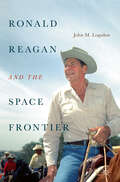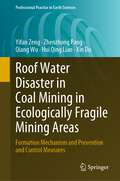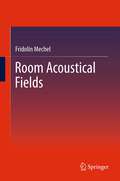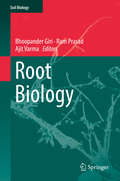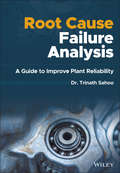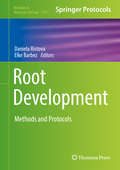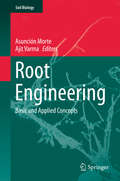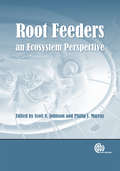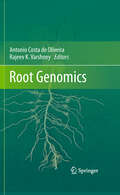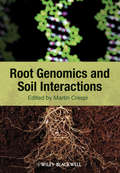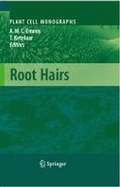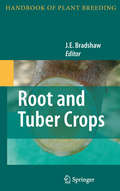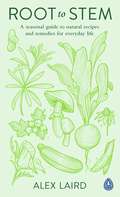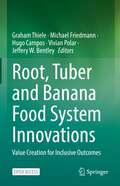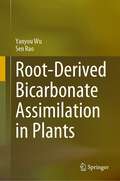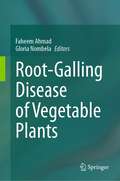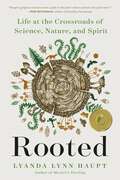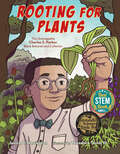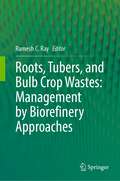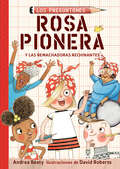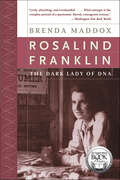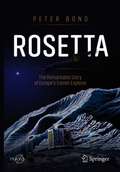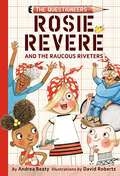- Table View
- List View
Ronald Reagan and the Space Frontier (Palgrave Studies in the History of Science and Technology)
by John M. LogsdonWhen Ronald Reagan was elected in 1980, limits on NASA funding and the lack of direction under the Nixon and Carter administrations had left the U.S. space program at a crossroads. In contrast to his predecessors, Reagan saw outer space as humanity’s final frontier and as an opportunity for global leadership. His optimism and belief in American exceptionalism guided a decade of U.S. activities in space, including bringing the space shuttle into operation, dealing with the 1986 Challenger accident and its aftermath, committing to a permanently crewed space station, encouraging private sector space efforts, and fostering international space partnerships with both U.S. allies and with the Soviet Union. Drawing from a trove of declassified primary source materials and oral history interviews, John M. Logsdon provides the first comprehensive account of Reagan’s civilian and commercial space policies during his eight years in the White House. Even as a fiscal conservative who was hesitant to increase NASA’s budget, Reagan’s enthusiasm for the space program made him perhaps the most pro-space president in American history.
Roof Water Disaster in Coal Mining in Ecologically Fragile Mining Areas: Formation Mechanism and Prevention and Control Measures (Professional Practice in Earth Sciences)
by Yifan Zeng Zhenzhong Pang Qiang Wu Hui Qing Lian Xin DuThis book targets to earth scientists and engineers, in particular students, researchers, managers, and practitioners, who are interested in mining engineering, environmental engineering, green coal mining, sustainable water resource management, and effective measures to balance mine safety and ecological conservation. In the disciplines of mine hydrogeology and mining engineering, there have always been difficulties in the theoretical interpretation of the changes in the physical and hydraulic characteristics of water resisting strata during coal seam mining. In the past 10 years, the authors studied the relevant contents by using the methods of physical simulation, numerical simulation, field test and mining practice of similar materials, so as to understand the internal relationship between the stratigraphic sedimentary characteristics of the mining area and the occurrence mechanism of mine water disaster. On the premise of analyzing and studying the stratigraphic sedimentary environment in the mining area in detail, it is of great significance for the realization of "coal water" dual resource mining in the mining area to divide the types of roof water disaster in the mining area and study the formation mechanism of mine water disaster caused by different rock formation combinations and mining methods.
Room Acoustical Fields
by Fridolin MechelThis book presents the theory of room acoustical fields and revises the Mirror Source Methods for practical computational use, emphasizing the wave character of acoustical fields. The presented higher methods include the concepts of "Mirror Point Sources" and "Corner sources which allow for an excellent approximation of complex room geometries and even equipped rooms. In contrast to classical description, this book extends the theory of sound fields describing them by their complex sound pressure and the particle velocity. This approach enables accurate descriptions of interference and absorption phenomena.
Room Temperature Photon Detectors
by Antoni Rogalski Weida Hu Piotr MartyniukRoom Temperature Photon Detectors provides an overview of the performance of emerging new generation of room temperature photodetectors generally called low-dimensional solid (LDS) photodetectors among which the most important are two-dimensional (2D) materials, perovskites, and quantum dots (QDs)/nanowires (NWs) operating in a wide spectral range from the ultraviolet (UV), visible (VIS), far infrared (FIR) to terahertz (THz). The LDS reported performance at room temperature is even better than that presented for standard commercial photodetectors.This book describes the peculiarities of the physical properties of LDS materials and their impact on the photodetectors’ performance. It also undertakes a comprehensive analysis of these performances when confronted with the standard photodetectors dominating the global market.Currently, intensive efforts are being made to reduce the cost of imaging systems and, in particular in the infrared (IR) range, to increase their operating temperature by reducing size, weight and power consumption (SWaP). This raises the question of whether the emergence of a new generation of LDS photodetectors will result in their rapid commercialization and serious competition for the standardized bulk photodetectors. This book attempts to answer those issues/questions.Features• Defines the importance of LDS photodetectors in the broad group of standard UV, VIS, IR, and THz photodetectors, and includes their advantages/disadvantages• Covers different types of photodetectors, including the relevant aspects of theory, types of materials, their physical properties, and detector fabrication• Provides invaluable resource for graduate students in physics and engineering, as well as a guide for those already working with sensors and systems, thermal imaging, remote sensing, optical telecommunications, and light detection.
Root Biology: Basic And Applied Concepts (Soil Biology Ser. #52)
by Ajit Varma Ram Prasad Bhoopander GiriThe book ‘Root Biology’ written by experts in the field, covers latest research on cellular, genetic, physiological and ecological developmental facets of root growth as well as the interaction of root with an array of microbes whether for the establishment of symbiosis, increasing plant growth or protecting plant from pathogens/attackers. Plant roots provide an excellent model to study physiological, developmental and metabolic processes at a system level. Root system architecture - an excellent creation of nature, is closely interconnected with the availability of soil nutrients. Several strategies including biotechnological interventions are gaining interest and importance for sustainable food production and enhanced resource acquisition. Such strategies have largely focused on root traits for efficient utilization of soil resources. The biotechnological application of root biology is expected to promote the production of food while maintaining ecologically and economically sustainable production systems.With a fortune of information on technical and experimental aspects useful in the laboratory, this extensive book is a valuable resource for researchers, academician and students in the broad field of microbiology, plant and fungal biology.
Root Cause Failure Analysis: A Guide to Improve Plant Reliability
by Trinath SahooRoot Cause Failure Analysis Provides the knowledge and failure analysis skills necessary for preventing and investigating process equipment failuresProcess equipment and piping systems are essential for plant availability and performance. Regularly exposed to hazardous service conditions and damage mechanisms, these critical plant assets can result in major failures if not effectively monitored and assessed—potentially causing serious injuries and significant business losses. When used proactively, Root Cause Failure Analysis (RCFA) helps reliability engineers inspect the process equipment and piping system before any abnormal conditions occur. RCFA is equally important after a failure happens: it determines the impact of a failure, helps control the resultant damage, and identifies the steps for preventing future problems.Root Cause Failure Analysis: A Guide to Improve Plant Reliability offers readers clear understanding of degradation mechanisms of process equipment and the concepts needed to perform industrial RCFA investigations. This comprehensive resource describes the methodology of RCFA and provides multiple techniques and industry practices for identifying, predicting, and evaluating equipment failures. Divided into two parts, the text first introduces Root Cause Analysis, explains the failure analysis process, and discusses the management of both human and latent error. The second part focuses on failure analysis of various components such as bolted joints, mechanical seals, steam traps, gearboxes, bearings, couplings, pumps, and compressors. This authoritative volume:Illustrates how failures are associated with part integrity, a complete system, or the execution of an engineering processDescribes how proper design, operation, and maintenance of the equipment help to enhance their reliabilityCovers analysis techniques and industry practices including 5-Why RCFA, fault tree analysis, Pareto charts, and Ishikawa diagramsFeatures a detailed case study of process plant machinery and a chapter on proactive measures for avoiding failuresBridging the gap between engineering education and practical application, Root Cause Failure Analysis: A Guide to Improve Plant Reliability is an important reference and guide for industrial professionals, including process plant engineers, planning managers, operation and maintenance engineers, process designers, chemical engineers, and instrument engineers. It is also a valuable text for researchers, instructors, and students in relevant areas of engineering and science.
Root Development: Methods And Protocols (Methods In Molecular Biology #1761)
by Daniela Ristova Elke BarbezThis detailed volume provides diverse elegant methods, complemented with existing protocols, which are optimized for the current needs in plant root biology as well as for use in plant species other than Arabidopsis thaliana. The collection covers methods ranging from genetic screens, phenotypic analysis, and cell biology methods to systems biology tools and genome-wide approaches. The collection contains a range of complexity from fundamental methods for quantification of different root developmental processes to complex methods that require sophisticated equipment. Written for the highly successful Methods in Molecular Biology series, chapters include introductions to their respective topics, lists of the necessary materials and reagents, step-by-step, readily reproducible laboratory protocols, and tips on troubleshooting and avoiding known pitfalls. Authoritative and practical, Root Development: Methods and Protocols serves as a valuable tool for plant biologists specialized in root development, from beginners to experienced researchers in the field.
Root Engineering
by Ajit Varma Asunción MorteThis volume illustrates the complex root system, including the various essential roles of roots as well as their interaction with diverse microorganisms localized in or near the root system. Following initial chapters describing the anatomy and architecture as well as the growth and development of root systems, subsequent chapters focus on the various types of root symbiosis with bacteria and fungi in the rhizosphere. A third section covers the physiological strategies of roots, such as nitrate assimilation, aquaporins, the role of roots in plant defense responses and in response to droughts and salinity changes. The book's final chapters discuss the prospects of applied engineering of roots, i. e. , inventing new root structures or functions through genetic modification, but also with conventional breeding and manipulation of root symbionts. The budding field of root engineering is expected to promote a second green revolution.
Root Feeders: An Ecosystem Perspective
by Scott N. Johnson Philip J. MurrayInteractions between plants and herbivores can have a significant effect on plant growth and development, and ultimately, on a plant's economic value. Research has traditionally focused on above ground herbivores, despite the considerable role that below ground herbivory by both vertebrates and invertebrates can play within a range of ecosystem processes. Root feeders have been classified as agricultural pests but can also be used as biological control agents against invasive species and can affect community dynamics of plants, soil micro-organisms and populations of above ground organisms. Bringing together a broad range of viewpoints and approaches, Root Feeders presents a comprehensive review of knowledge on root herbivores and illustrates their importance within ecosystems. Chapters discuss problems of visualizing the organisms in the soil, their role in agriculture, grassland and forest ecosystems, and present specific case studies on the management, control and influence of root feeders. Covering all aspects from food web ecology to the effects of climate change, this will be valuable reading for researchers and professionals in agricultural entomology, plant science, ecology and soil science.
Root Genomics
by Antonio Costa de Oliveira Rajeev VarshneyWith the predicted increase of the human population and the subsequent need for larger food supplies, root health in crop plants could play a major role in providing sustainable highly productive crops that can cope with global climate changes. While the essentiality of roots and their relation to plant performance is broadly recognized, less is known about their role in plant growth and development. "Root Genomics" examines how various new genomic technologies are rapidly being applied to the study of roots, including high-throughput sequencing and genotyping, TILLING, transcription factor analysis, comparative genomics, gene discovery and transcriptional profiling, post-transcriptional events regulating microRNAs, proteome profiling and the use of molecular markers such as SSRs, DArTs, and SNPs for QTL analyses and the identification of superior genes/alleles. The book also covers topics such as the molecular breeding of crops in problematic soils and the responses of roots to a variety of stresses.
Root Genomics and Soil Interactions
by Martin CrespiFully integrated and comprehensive in its coverage, Root Genomics and Soil Interactions examines the use of genome-based technologies to understand root development and adaptability to biotic and abiotic stresses and changes in the soil environment. Written by an international team of experts in the field, this timely review highlights both model organisms and important agronomic crops. Coverage includes: novel areas unveiled by genomics research basic root biology and genomic approaches applied to analysis of root responses to the soil environment. Each chapter provides a succinct yet thorough review of research.
Root Hairs
by Anne Mie Emons Tijs KetelaarRoot hairs, the tip-growing extensions of root epidermal cells, are a model system for answering many plant cell and developmental biology research questions. This book, written by experts in the field, covers the research up to 2008 on cellular, genetic, electrophysiological and developmental aspects of root hair growth, as well as the interaction of root hairs with rhizobia and mycorrhizae in the establishment of symbiosis. With a wealth of information on technical and experimental aspects useful in the laboratory, this comprehensive book is a valuable resource for researchers and students in the broad field of plant cell and molecular biology.
Root and Tuber Crops
by J. E. BradshawIt is important to include Tuber and Root Crops in the Handbook of Plant Breeding. They include starchy staple crops that are of increasing importance for global food security and relief of poverty, important millennium goals for the United Nations. Indeed, 2008 was the UN International Year of the Potato in recognition of this role of the potato as the world's third most important food crop after wheat and rice. The other major staples are cassava, sweetpotato and yam. Together they occupy about 50 million hectares, with production at 640 million metric tons, of which 70% is in developing countries. In total there are more than 30 species of Root and Tuber Crops grown in the world today. Given the content of other volumes in the series, it makes sense to include sugar and fodder beets; swedes and turnips; and minor root and tuber crops so that the book series is as complete as possible. Like the other volumes in the series, this one will present information on the latest in applied plant breeding using the current advances in the field, from an efficient use of genetic resources to the impact of biotechnology in plant breeding. Seven crop specific chapters are proposed, together with an introduction to this diverse set of plant species. Outstanding scientists for each crop species are proposed as senior authors, who may invite co-authors to contribute part of a chapter. In order to increase the overall acceptance of the volume, balance will be sought with authors from different research groups/countries who will be asked to contribute and collaborate where appropriate. The book should be of interest to researchers in both academic and industrial settings, and in both developed and developing countries, as well as students and teachers of plant breeding. It is currently extremely important to educate and train a new generation of plant breeders given the challenges faced by humankind in producing more food for an expanding global population during a period of environmental (including climate) change.
Root to Stem: A seasonal guide to natural recipes and remedies for everyday life
by Alex Laird'Root to Stem is a seasonal and holistic approach to health that puts plants, herbs and nature at the heart of how we live and eat. It is a new kind of guide that links individual health to our communities and the planet's health to sustain us all.'This perfect companion to the seasons, this book will show you how to take greater control over your own health and well-being, treat everyday ailments, and ensure the sustainability of the planet through discovering how to forage, grow, or shop for plant- and herb-based foods and products. Including: Detox in the spring with sorrel, cleavers and nettles. Harvest summer lime leaf shoots to soothe digestive upsets and feed gut microbes. Bake a Lammas loaf to celebrate the autumnal equinox. Boost your winter immunity with red berries, purple potatoes and rosehips. Root-to-stem eating encourages you to use every edible part of plant, including the leaves, skin, seeds and stalks.Travelling through the four seasons, expert medical herbalist Alex Laird shares the natural ingredients that are available on your doorstep, simple delicious recipes and easy-to-make herbal remedies.
Root, Tuber and Banana Food System Innovations: Value Creation for Inclusive Outcomes
by Graham Thiele Hugo Campos Michael Friedmann Vivian Polar Jeffery W. BentleyThis open access book describes recent innovations in food systems based on root, tuber and banana crops in developing countries. These innovations respond to many of the challenges facing these vital crops, linked to their vegetative seed and bulky and perishable produce. The innovations create value, food, jobs and new sources of income while improving the wellbeing and quality of life of their users. Women are often key players in the production, processing and marketing of roots, tubers and bananas, so successful innovation needs to consider gender. These crops and their value chains have long been neglected by research and development, hence this book contributes to filling in the gap. The book features many outcomes of the CGIAR Research Program in Roots, Tubers and Banana (RTB), which operated from 2012-21, encompassing many tropical countries, academic and industry partners, multiple crops, and major initiatives. It describes the successful innovation model developed by RTB that brings together diverse partners and organizations, to create value for the end users and to generate positive economic and social outcomes. RTB has accelerated the scaling of innovations to reach many end users cost effectively. Though most of the book’s examples and insights are from Africa, they can be applied worldwide. The book will be useful for decision makers designing policies to scale up agricultural solutions, for researchers and extension specialists seeking practical ideas, and for scholars of innovation.
Root-Derived Bicarbonate Assimilation in Plants
by Yanyou Wu Sen RaoThis book summarizes the physiological effects of bicarbonate in plants and systematically introduces readers to a bidirectional isotope labeling tracer technique used to quantify the contribution of root-derived bicarbonate to total photosynthetic inorganic carbon assimilation in plants. This method helps to shed light on the role of dissolved inorganic carbon from the soil in overall photosynthesis, an aspect that has been underestimated or neglected entirely in the past. The book quantifies the capacity for root-derived bicarbonate assimilation in certain plant species and illustrates the coupling relationship between karstification and photosynthesis. Further, it demonstrates that root-derived bicarbonate utilization is as important as stomatal-derived inorganic carbon assimilation in biological evolution and plant adaptation to the environment. Using numerous models, it also illustrates carbon isotopic mixtures in complex inorganic carbon utilization and supplements the results with numerical calculations presented as tables and figures. In short, the book offers a strikingly new perspective on photosynthesis.
Root-Galling Disease of Vegetable Plants
by Faheem Ahmad Gloria NombelaThis book provides the most comprehensive and up-to-date review of research on vegetable plants associated with root-galls disease caused by root-knot nematodes (RKNs), Meloidogyne spp. Vegetables retain a key position in cultural cuisines and their consumption worldwide due to rich sources of micronutrients, including vitamins, minerals and antioxidants, but root galls disease of these crops caused by RKNs steals both quantity and quality from production. The field of plant nematology has experienced exponential growth over the past decade, and these RKNs are now known as widely damaging obligate plant parasites of vegetable plants. Advances are being made in understanding their biology, parasitism in the root system, giant cell development, root gall formation, chemical signalling, root-knot disease complexes, and management systems. This compilation provides an invaluable resource for studying root-galls disease of vegetable plants to those readers associated with plant nematology, plant pathology, plant protection, and agricultural science, including researchers, teachers, advanced undergraduates and graduate students, and even agricultural extension agents and farmers.
Root-Knot Nematodes
by Roland Perry Maurice Moens James L. StarrRoot-knot nematodes are the most economically important group of plant-parasitic nematodes worldwide, and their control presents a major global challenge. Advances are being made in understanding their biology, host-parasite interaction and management strategies, and this comprehensive guide with many color photos and contributions from international experts covers the taxonomy, classification, morphology, life-cycle biology, genomes, resistance, sampling, detection, and management strategies of these pests, providing an essential reference for researchers, students and lecturers in plant nematology, plant pathology, agriculture, and agronomy.
Rooted: Life at the Crossroads of Science, Nature, and Spirit
by Lyanda Lynn HauptDeepen your connection to the natural world with this inspiring meditation, "a path to the place where science and spirit meet" (Robin Wall Kimmerer).In Rooted, cutting-edge science supports a truth that poets, artists, mystics, and earth-based cultures across the world have proclaimed over millennia: life on this planet is radically interconnected. Our bodies, thoughts, minds, and spirits are affected by the whole of nature, and they affect this whole in return. In this time of crisis, how can we best live upon our imperiled, beloved earth?Award-winning writer Lyanda Lynn Haupt&’s highly personal new book is a brilliant invitation to live with the earth in both simple and profound ways—from walking barefoot in the woods and reimagining our relationship with animals and trees, to examining the very language we use to describe and think about nature. She invokes rootedness as a way of being in concert with the wilderness—and wildness—that sustains humans and all of life.In the tradition of Rachel Carson, Elizabeth Kolbert, and Mary Oliver, Haupt writes with urgency and grace, reminding us that at the crossroads of science, nature, and spirit we find true hope. Each chapter provides tools for bringing our unique gifts to the fore and transforming our sense of belonging within the magic and wonder of the natural world.
Rooting for Plants: The Unstoppable Charles S. Parker, Black Botanist and Collector
by Janice N. HarringtonMeet Charles S. Parker, an unsung yet trailblazing Black scientist who made major contributions to the fields of botany (the study of plants) and mycology (the study of fungi) in this inspiring STEM/STEAM picture book biography.In 1882, Black botanist and mycologist Charles S. Parker sprouted up in the lush, green Pacific Northwest. From the beginning, Charles&’s passion was plants, and he trudged through forests, climbed mountains, and waded into lakes to find them. When he was drafted to fight in World War I, Charles experienced prejudice against Black soldiers and witnessed the massive ecological devastation that war caused. Those experiences made him even more determined to follow his dreams, whatever the difficulties, and to have a career making things grow, not destroying them.As a botanist and teacher, Charles traveled the United States, searching for new species of plants and fungi. After discovering the source of the disease killing peach and apricot trees, Charles was offered a job at Howard University, the famed historically Black college where he taught the next generation of Black scientists—men and women—to love plants and fungi as much as he did.
Roots, Tubers, and Bulb Crop Wastes: Management by Biorefinery Approaches
by Ramesh C. RayThis edited book brings forth comprehensive information on the bioprocessing and biovalorization of root (i.e., cassava, sweet potato, yams, and aroids), tuber (i.e., potato, carrot, turnip, artichoke and beet root), and bulb (i.e., onion and garlic) crop wastes into various products and platform chemicals in a biorefinery approach. The non-edible portion of roots, tubers, and bulb crops, after processing (waste), such as peels, skins, pulps, rejects, and unmarketable tubers, account for about 20–40% of the total weight of the fresh produce. Tropical tuber crops such as cassava, yams, aroids, and sweet potato generate bagasse, the byproduct of the starch processing industry, which contains about 30–50% starch and fibrous materials on a dry weight basis. Similarly, the husk is the leading waste from onion and garlic processing. The amount of waste and byproducts of potato industry is estimated to be around 12–20% of their total production. These wastes pose increasing disposal and potentially severe pollution problems and represent a loss of valuable biomass and nutrients. Roots, tubers, and bulb wastes usually have a composition of sugar, starch, proteins, phenolic phytochemicals, fibers, and minerals. Therefore, they should not be considered as “wastes” but raw materials for other industrial processes in the biorefinery approach. These wastes provide conditions amenable for the growth of microorganisms and opens up great opportunities for their reuse in fermentation processes to develop value-added bioproducts such as enzymes, single-cell proteins, bio-absorbents, phenolic bioactive compounds, aroma and flavor compounds, organic acids, and biofuels. This book fills the gap in literature about the processes and by-products. The book is composed of 16- chapters deep diving into valorization and bioprocessing of a range of tuber crop waste. The book explores these processes in 11 different crops and highlights the life cycle assessment as well as highlightsthe opportunities about commercialization of technologies used in bioprocessing and bio-valorization of root crop waste. The processes explained in the book are rooted in the principles of circular economy. This book is of interest to teachers, researchers, environmentalists, bio-based industrialist, and policymakers.
Rosa Pionera y las remachadoras rechinantes (Los Preguntones / The Questioneers Ser. #1)
by BEATY, ANDREA / ROBERTS,DAVID«¡Bestseller del New York Times! Continúan las aventuras de los Preguntones: Rosa Pionera, Ada Magnífica y Pedro Perfecto, ahora en una nueva serie de libros de capítulos cortos. La primera entrega, Rosa Pionera y las Remachadoras Rechinantes, es una historia enérgica sobre el poder del trabajo en equipo y el verdadero significado del hogar. Rosa Pionera conoce de fracasos, fallas, catástrofes y contratiempos. Después de todo, ¡la ingeniería tiene mucho que ver con la perseverancia! Pero esta vez, Rosa tiene un proyecto muy importante; uno que parece superior a sus posibilidades. Su querida tía-bisabuela Rosie y sus amigas, las Remachadoras Rechinantes, un grupo de divertidas mujeres que construyeron aviones durante la Segunda Guerra Mundial, necesitan ayuda para inventar algo nuevo. ¡Y Rosa es la ingeniera perfecta para la tarea! Después de un fracaso# luego otro# y otro más# Rosa comienza a perder la esperanza. Pero gracias a la ayuda de sus amigos Pedro Perfecto y Ada Magnífica, Rosa completa con éxito la misión. Y, junto con las Remachadoras, redescubre el significado del hogar.
Rosalind Franklin: The Dark Lady of DNA
by Brenda MaddoxIn 1962, Maurice Wilkins, Francis Crick, and James Watson received the Nobel Prize, but it was Rosalind Franklin's data and photographs of DNA that led to their discovery.Brenda Maddox tells a powerful story of a remarkably single-minded, forthright, and tempestuous young woman who, at the age of fifteen, decided she was going to be a scientist, but who was airbrushed out of the greatest scientific discovery of the twentieth century.
Rosetta: The Remarkable Story of Europe's Comet Explorer (Springer Praxis Books)
by Peter BondIn 2014, Rosetta became the first mission to orbit a comet and to deploy a lander onto its surface. This is the story of ESA’s pioneering comet explorer, following the mission from its initial inception to its historic touchdown. Read along as the Rosetta orbiter and its lander, Philae, evolve over the years, overcoming early mission hurdles before embarking on their one-way, decade-long voyage to a comet. See how the saga then culminates with Rosetta and Philae at last unveiling their icy target and achieving an unprecedented touchdown on its surface.Award-winning space writer Peter Bond takes us behind the scenes of this historic endeavor, sharing insights from the international team of scientists and engineers who made the mission possible, describing the remarkable technology that they created, and delving into the treasure trove of scientific discoveries that followed.Recounting in vivid detail the inner workings of Rosetta, this book is a celebration of the mission that has left a lasting impact on planetary science and space exploration.
Rosie Revere And The Raucous Riveters
by David Roberts Andrea Beaty<P><P>Rosie Revere is no stranger to flops and fails, kerfuffles and catastrophes. After all, engineering is all about perseverance! But this time, Rosie has a really important project to tackle--one that feels much bigger than herself. <P><P> Rosie's beloved Aunt Rose and her friends, the Raucous Riveters--a group of fun-loving gals who built airplanes during World War II--need help inventing something new. And Rosie is just the engineer for the job! <P><P> After one flop . . . then another . . . and another . . . Rosie starts to lose hope. But thanks to some help from her fellow Questioneers Iggy Peck and Ada Twist, Rosie gets the job done. And, along with the Riveters, she rediscovers the meaning of home. <P><P> Collect them all! Add these other STEM favorites from #1 New York Times bestselling team Andrea Beaty and David Roberts to your family library today! <P><P> Rosie Revere, Engineer Ada Twist, Scientist Iggy Peck, Architect Ada Twist and the Perilous Pants Ada Twist's Big Project Book for Stellar Scientists Iggy Peck's Big Project Book for Amazing Architects Rosie Revere's Big Project Book for Bold Engineers
